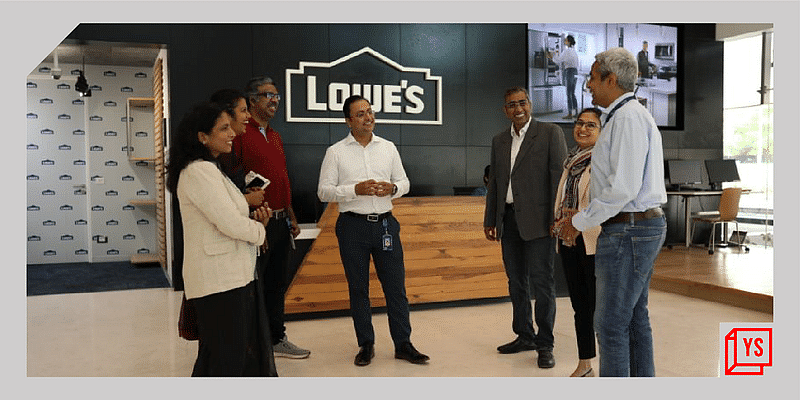Data is critical across industries and the story isn’t any different at Lowe’s, one of the largest home improvement retailers in the world. At Lowe’s, data and analytics forms the secret sauce for better decision making that powers their $96 billion business. Their Data Analytics and Computational Intelligence (DACI) team is responsible for supporting business functions in taking data-driven decisions across all verticals of home improvement retail.
To gain further insights into the data division at Lowe’s and how data is leveraged across the company, we spoke to Issac Mathew, Senior Director, Technology, DACI supply chain, Lowe’s India. As the India leader for DACI, Issac oversees various functions from data science, data engineering, data analysis, software engineering to product management.
Edited excerpts from the interview:
YourStory: You lead several data focused verticals at Lowe’s. How does your team help in scaling the business for Lowe’s?
Issac Mathew: At Lowe’s, my team and I help build shrink-wrapped products with baked-in intelligence for our business users and help them make better decisions using data. Intelligent products can be anything that is consumed directly by the business user. But it can also be consumed by another tech suite. An end-to-end product will need a good user interface because the end-user doesn’t want to deal with models and algorithms. Hence, a lot of focus goes into making insights consumable. Leading over 160 bright and highly talented associates, I oversee five key teams, which include:
- Data science – this is the team that creates solutions that have intelligence using technologies such as artificial intelligence / machine learning (AI/ML). Every predictive or optimised model, which is like a prescriptive model, is at the core of our data science team’s responsibility. We help answer critical business questions, among others, such as – How much are we going to sell? How much inventory is going to flow through our distribution centres? Will consumers respond to this campaign? How do I recommend products? What is the right product to recommend? What should the right price be?
- Data engineering – the engineers focus on scaling-up role and architecting the right solutions, ensuring that the data ingestion part is taken care of. Doing small proof-of-concepts (POCs) is not good enough for us; we solve data engineering problems at scale to drive business impact.
- Data analysts at Lowe’s India help provide answers to immediate questions/ diagnostic queries like – Why did something happen? Why do I see a blip? Why am I having a choke point at this supply chain node? It’s mostly backward-looking, but they keep the business engaged and leverage their deep understanding of the domain to provide rapid and actionable insights.
- Software engineering – experts in the team ensure that systems are functional, usable, scalable, and architectured well. The user interface and experiences are seamlessly tied with the existing IT systems.
- Product management teams ensure that the requirements are captured accurately and the product’s roadmap is laid out; they perform the crucial role of liaising with the business and ensuring that the prioritisation is done.
YS: Data plays a significant role across industries today. It is one of the biggest business enablers for Lowe’s as well. Why is it so important?
IM: Lowe’s is a fast-growing Fortune 50 company and to run such a company, we cannot make decisions based on our gut feeling. At the current scale, it becomes critical for us to use data analytics for decision making by building data products. For instance, one of the data products we use is called Data Excellence, where we are focused on ingestion, cleansing, curation, and making sure that the end-users see only one version of the truth.
If you don’t have clean, reliable data at scale, then any down-stream models will not work. However, having data alone is not good enough. The business churns out petabytes of data, and our focus is on taking only that data which is right and usable. If we don’t build the right models, our business cannot make the right decisions to ensure that we are operating at peak efficiency. It, therefore, becomes a smart play of clean data and powerful models that enable decision making.
YS: With millions of customers, data becomes essential for a company like yours. What are the challenges you have overcome with data and analytics?
IM: Some of the main challenges lie in the volume, cleanliness, and timely data availability; these can be overcome with a combined effort of technology and processes. Customer data is more about finding meaningful patterns and making informed decisions and as we move into our analytics journey. Traditionally, marketing analytics was more of reporting, dashboarding, and backward-looking analysis. But we have devised some advanced models to understand customer lifetime value and campaign effectiveness and propensity models.
Another huge opportunity is leveraging the sponsored space on our website and getting the vendors advertising space to push up their products. All this is data-driven. Data and information security is another concern that too can be handled with tools. We have a specific team that is purely focused on the security side of data—data leakage and prevention. It’s a mix of technology, as well as tools, processes, awareness, and audits.
YS: What role does AI/ML play across Lowe’s?
IM: Almost every function here at Lowe’s has utilised AI/ML technologies to varying degrees. Forecasting is a big deal at the point-of-sale level on the supply chain side. It helps answer critical questions such as – What’s going to sell? Or how much is flowing through the network? Another area I can think of is inventory management. Given our scale and business complexity arising due to various macro and microeconomic factors, we have developed a sophisticated solution that is helping our business make decisions about how much to keep in buffer stock. Another important use case is sourcing optimisation, which deals with the best delivery locations. As multiple locations hold the same item, answering where we should ship it from often becomes tricky. We use AI/ML to answer such questions.
We are leveraging the latest deep learning techniques to prevent theft at the self-checkout counter in stores. In addition, we are applying AI/ML solutions to identify which part of the store is a hotspot with more customers in real-time and making sure that there are associates who can help if we see more traction towards a particular aisle. Likewise, on the merchandising side, AI/ML helps us identify the items we should keep and how much. On the finance side, we have models in place to identify risks ahead of time and model margins.
YS: The Data Analytics team at Lowe’s India is growing. What plans do you have in the pipeline? Are you building industry-leading data products?
IM: Creating intelligent products is important to help our business make informed decisions to provide an unparalleled customer experience. We strive to deliver a world-class product that is widely adopted. We are working on creating intelligent products in a quick turnaround, fast, reliable, and sustainable way. For instance, our finance team has been working on the margins analysis, making sure that the sourcing is done right. The merchandising teams are working on insights on sourcing. Marketing teams are gathering insights on understanding the kind of customer to be targeted, areas that will improve our campaigns’ ROI and identify new channels. We’ve also covered a lot of ground in media mix modeling which is allocating a fixed budget optimally across different channels.
Broadly, our approach is to first create the need for people to use remote solutions and then build them over at Lowe’s. But the capability to build products is not enough, its adoption is equally important. And that requires a fine balance between evangelisation as well as building better products. At Lowe’s, we first try to find out if the solution is suited for the use case, then we enable the business to ask questions that bring out different problems. With this, we enable more people to have a seat at the table when solutioning is going on and try to flesh out the real problem.
YS: What sets the Data and Analytics department apart at Lowe’s?
IM: We have been ranked amongst the top five best firms for data scientists to work for in India, two years in a row. But apart from rankings, Lowe’s is a great place to work primarily because of the tremendous support we extend in terms of infrastructure and a culture of continuous learning with cross-functional teams that we have built over time.
Speaking specifically about our DACI team, we have something called internal huddles, where we showcase our projects, bring internal and external speakers, and have demo days. We also try flexi resourcing options, so people learn from each other, which benefits the whole organisation.
Our senior leaders, including our CIO, are equally invested in the work we do, and they join us during our quarterly demo days at the functional level. This gives a platform for our associates to showcase work and get feedback from our leaders. We also have Lowe’s University, which ties up with providers such as Coursera and Pluralsight to offer certification courses that come with curated pathways to help associates upskill.
And, we have hired phenomenal talent from India’s premier institutes and best-in-class organisations who are at the forefront of analytics and data science. To sum it all up, Lowe’s offers ample opportunity to work and learn, a great culture and a healthy work-life balance.
Interested in building a career in the data and analytics domain with a certified Great place to Work?










